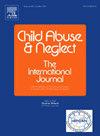英国寄宿儿童的风险脆弱性:一项多层次模型研究
IF 3.4
2区 心理学
Q1 FAMILY STUDIES
引用次数: 0
摘要
生活在寄宿家庭的儿童被认为是社会上最需要帮助的儿童,然而很少有研究研究他们共同发生的冒险行为,如失踪、药物滥用、犯罪行为、自残和自杀。目的探讨英国寄宿儿童对外部风险和自身风险的脆弱性。参与者和环境:1114名儿童(46%为女性),年龄在5至18岁(M = 13.8, SD = 2.2),住在寄宿机构(儿童之家和半独立住所)。方法采用常规收集的住院护理人员的档案数据,这些人员完成了关于他们所照顾的儿童的在线BERRI问卷。结果与儿童之家相比,半独立住宿的儿童平均受到的外部风险伤害程度更高(p <;. 01)。由于数据结构嵌套,采用多级建模。最近经历较多生活事件的儿童更容易受到外部风险的伤害(β = 1.58, p <;.001)和自我风险(β = 0.31, p <;. 01)。年龄越大,外部风险危害越大(β = 1.24, p <;.001),女生自杀风险较高(β = 2.53, p <;措施)。结论不同群体的寄宿儿童存在不同类型的风险。对儿童的风险进行常规评估,同时对住院工作人员进行培训,对于识别、监测和防范潜在危害至关重要。本文章由计算机程序翻译,如有差异,请以英文原文为准。
Risk vulnerability among children living in residential care in England: A study using multi-level models
Background
Children living in residential care are seen as some of the highest need children in society, yet there is scarce research studying their co-occurring risk-taking behaviours such as going missing, substance misuse, criminal behaviour, self-harm, and suicidality.
Objective
This study aimed to investigate the patterns of vulnerability to harm from external risk and risk to self among children living in residential care in England.
Participants and setting
1114 children (46 % female), aged 5 to 18 years (M = 13.8, SD = 2.2), living in residential care (children's homes and semi-independent accommodation).
Methods
Archival data collected routinely from residential care staff who complete the online BERRI Questionnaire about children in their care were used.
Results
On average children in semi-independent accommodation had higher levels of harm from external risk, compared to those in children's homes (p < .01). Multi-level modelling was used due to the nested data structure. Children who experience a greater number of recent life events had greater vulnerability to harm from external risk (β = 1.58, p < .001) and risk to self (β = 0.31, p < .01). Older age related to greater harm from external risks (β = 1.24, p < .001), and being a girl related to greater risk to self (β = 2.53, p < .001).
Conclusions
Certain groups of children in residential care are vulnerable to different types of risk. Routine assessment of children's risk, alongside training for residential staff, is essential to identify, monitor and safeguard against potential harms.
求助全文
通过发布文献求助,成功后即可免费获取论文全文。
去求助
来源期刊

Child Abuse & Neglect
Multiple-
CiteScore
7.40
自引率
10.40%
发文量
397
期刊介绍:
Official Publication of the International Society for Prevention of Child Abuse and Neglect. Child Abuse & Neglect The International Journal, provides an international, multidisciplinary forum on all aspects of child abuse and neglect, with special emphasis on prevention and treatment; the scope extends further to all those aspects of life which either favor or hinder child development. While contributions will primarily be from the fields of psychology, psychiatry, social work, medicine, nursing, law enforcement, legislature, education, and anthropology, the Journal encourages the concerned lay individual and child-oriented advocate organizations to contribute.
 求助内容:
求助内容: 应助结果提醒方式:
应助结果提醒方式:


